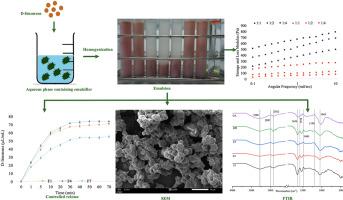用大麻分离蛋白和阿拉伯胶的非共价凝聚物微胶囊化d -柠檬烯
IF 5.8
2区 农林科学
Q1 ENGINEERING, CHEMICAL
引用次数: 0
摘要
本研究探讨了复合凝聚的pH范围和最佳pH (pHopt)对d -柠檬烯微胶囊性能的影响。用大麻分离蛋白(HPI)和阿拉伯胶(GA)形成的凝聚体稳定水包油乳液。总生物聚合物浓度固定为1.2% (1% HPI, 0.2% GA),芯壁比为1:1至1:4。在pH 2.0-5.0范围内发生凝聚,其中pH 3.0-4.0为最佳。流变学分析表明,储存(G ')比损失(G″)模量更高,表现出凝胶状行为。配方F4的收率最高,为64.06%,配方F9的收率最低,为45.44%,说明不同样品的喷雾干燥效率存在差异。F4的d -柠檬烯有效负荷最高(44.21%),F9最低(12.51%),F4包封效率最高(88.05%),F7最低(62.03%)。所有样品的水活度都很低(0.14 - 0.20),其中F2最低(0.14),中位粒径范围为6.23 μm (F3)至7.39 μm (F1),反映了液滴大小的适度变化。pH为3.0、4.0和7.0时形成的微胶囊的形态差异对其结构有显著影响。样品F1-F3由于含油量高,微胶囊结构更明确,荧光较强,而FTIR证实在凝聚过程中参与了非共价相互作用。d -柠檬烯的释放遵循扩散控制动力学(Weibull, b < 1)。这项工作支持天然的、可生物降解的系统的开发,用于控制食品、制药和化妆品中挥发性化合物的释放。本文章由计算机程序翻译,如有差异,请以英文原文为准。

Microencapsulation of D-limonene through non-covalent coacervates of hemp protein isolate and gum Arabic
This study explores the impact of pH range and optimal pH (pHopt) for complex coacervation on the properties of microcapsules containing D-limonene. An oil-in-water emulsion stabilized by coacervates formed from hemp protein isolate (HPI) and gum arabic (GA) was used. The total biopolymer concentration was fixed at 1.2 % (1 % HPI, 0.2 % GA), with core-to-wall ratios from 1:1 to 1:4. Coacervation occurred within pH 2.0–5.0, with pH 3.0–4.0 identified as optimal. Rheological analysis showed higher storage (G′) than loss (G″) moduli, indicating gel-like behavior. Formulation F4 achieved the highest yield at 64.06 %, while F9 had the lowest at 45.44 %, indicating variation in spray-drying efficiency across samples. The highest pay load of D-limonene (44.21 %) was observed for F4, whereas F9 had the lowest pay load of 12.51 %, and encapsulation efficiency also peaked for F4 (88.05 %), with F7 showing the lowest (62.03 %). Water activity remained low in all samples (0.14–0.20), with F2 having the lowest (0.14) and median particle sizes ranged from 6.23 μm (F3) to 7.39 μm (F1), reflecting moderate variation in droplet size. Morphological differences among microcapsules formed at pH 3.0, 4.0, and 7.0 showed significant influence of pH on structure. Samples F1–F3 showed strong fluorescence due to higher oil content and more defined microcapsule structures while, the FTIR confirmed the involvement of non-covalent interactions during coacervation. The release of D-limonene followed diffusion-controlled kinetics (Weibull, b < 1). This work supports the development of natural, biodegradable systems for controlled release of volatile compounds in food, pharmaceutical, and cosmetic applications.
求助全文
通过发布文献求助,成功后即可免费获取论文全文。
去求助
来源期刊

Journal of Food Engineering
工程技术-工程:化工
CiteScore
11.80
自引率
5.50%
发文量
275
审稿时长
24 days
期刊介绍:
The journal publishes original research and review papers on any subject at the interface between food and engineering, particularly those of relevance to industry, including:
Engineering properties of foods, food physics and physical chemistry; processing, measurement, control, packaging, storage and distribution; engineering aspects of the design and production of novel foods and of food service and catering; design and operation of food processes, plant and equipment; economics of food engineering, including the economics of alternative processes.
Accounts of food engineering achievements are of particular value.
 求助内容:
求助内容: 应助结果提醒方式:
应助结果提醒方式:


